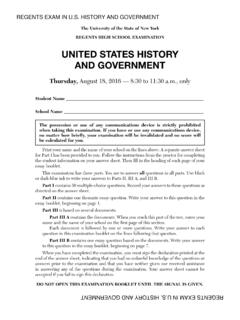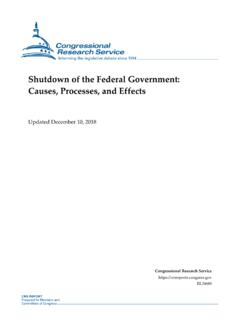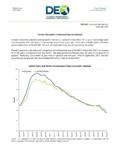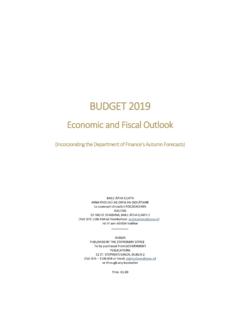Transcription of The Role of Government in Economic Development
1 The Role of Government in Economic DevelopmentNovember 2006Oh-Seok Hyun, Research InstituteKorea International Trade AssociationKorea s Economic Development & Economic Crisis ManagementContentsIIntroductionIIOvervie w of the Role of GovernmentIVMechanism of Government InterventionsIIIK orean ExperiencesVGlobalization and the Role of GovernmentVIConclusionKorea s Economic Development & Economic Crisis ManagementzGDP(2005) : $ 788 Billion - Malaysia + Indonesia + Thailand + Philippines = $ 687 Billion - Russia = $ 764 BillionzPer Capita GNI(2005) : $ 16,291 zTrade Value(2005) : $ 545 Billion - Exports : $ 284 Billion (12th)- Imports : $ 261 Billion (13th)zAverage Growth Rate(1970~2005) : (3th)zForeign Reserves (Jun 2006) : $ 224 Billion (5th)World s 12th largest EconomyTrade 12thGDP 12thForeign Reserves5thGrowth Rate 3th1 - 1. Korea s Economy I.
2 IntroductionKorea s Economic Development & Economic Crisis Management1 - 2. Government s RoleI. IntroductionMobilization and Allocation of ResourcesStabilization of the National EconomyPromotion of Technological Development Guardian of Political Stability Provider of Development Funds Major Investor in Industries of the Country Investment Decision of Private Enterprises Motivator behind the Scene Preservation of the Law and Order A Strong Agent of Social Change Protector of Social SecurityKorea s Economic Development & Economic Crisis ManagementII. Overview of the Role of Government2 - 1. The Neoclassical ViewzA Stable Macroeconomic EnvironmentzA Reliable Legal FrameworkzOrientation of International TradezThe Absence of Price Controls & other Distortional PolicieszInvestment in People, Education, HealthzStress on Human CapitalKorea s EconomicMiracleGetting the basics right !
3 Korea s Economic Development & Economic Crisis ManagementII. Overview of the Role of Government2 - 2. The Revisionist ViewKorea does not wholly conform to the neoclassical model !!zIndustrial policy and interventions in financial markets are noteasilyreconciled within the neoclassical policies in some economies are much more in accordance withmodels of state-led policy mixes used by the Korean Government were diverse andflexibleKorea s Economic Development & Economic Crisis ManagementII. Overview of the Role of Government2 - 3. The Market-Friendly ViewThe appropriate role of the Government in the market-friendly strategy(World Bank, World Development Report 1991)Otherwise, the Government intervention will do more harm than good !!zSecuring sufficient investment inhuman resourceszEnsuring an environment thatpromotes competition amongprivate enterpriseszMaintenance of an Economic system open to international tradezMaintenance of stable macro economyKorea s Economic Development & Economic Crisis ManagementII.
4 Overview of the Role of Government2 - 4. The Functional ApproachKorea s rapid growth based on three functions of growth : Accumulation / Efficient allocation / Rapid technological catch-upzMacroeconomic stabilityzInvestment in human capitalzStable and secure financialsystemzLimited price distortionszOpenness to foreign technologyzMild financial repression(positive but low interest rate)zDirected creditzSelective industrial promotionzTrade policies for nontraditional exportsFundamentalsFundamentalsSelective InterventionsSelective InterventionsKorea s Economic Development & Economic Crisis ManagementII. Overview of the Role of GovernmentThe Government distributes rewards on the basis of interventions must be disciplined by competition. Competitive SystemCompetitive SystemVery simple nonmarket allocationrules, such as access to rationalcredit for exportersVery complex coordinationof private investment in the Government -businessdeliberation councilsMajor characteristics of the competitive systemMajor characteristics of the competitive systemKorea s Economic Development & Economic Crisis ManagementII.
5 Overview of the Role of Government2 - 5. Overview of the Role of GovernmentA high-quality civil service that has the capacity to monitor performance and is insulated from political interference isessential to contest-based high-quality civil service also augmentsa Government s ability to design and implement non-contest-based flexibility in the pursuit of Economic objectives-the capacity and willingness to change policies-is as mucha hallmark of the Korean economy as any single policy instrument. Korea s EconomyKorea s EconomyKorea s Economic Development & Economic Crisis ManagementIII. Korean Experiences3 - 1. Review of Development Strategies in Korea(1) Launching Economic Development in the 1960sGovernment StrategiesGovernment StrategiesExecution of StrategiesExecution of StrategiesResultsResultszEconomic Development Outward-oriented Development strategyzEstablishing new institutions and strengthening existing organizationsto mobilize both internal & external resources EPB, tax administration, foreign capital promotion actzEliminating the fiscal deficitzIncreasing savings depositsKorea s Economic Development & Economic Crisis ManagementIII.
6 Korean Experiences One of the most important reforms was a revamping of trade Korean currency, the won, was devalued by nearly 100 unified exchange rate system was adopted that eliminated the bias against the export export credit was made available at a preferential rebates were allowed on raw materials imported for the productionof exports. zA number of free trade zones were also procedures were s Economic Development & Economic Crisis ManagementzTo develop a new source of strategic export industrieszTo promote the import substitution of intermediate materials andcapital goodsHeavy and Chemical Industry Development Plan (1973)III. Korean Experiences(2) Extensive Intervention in the 1970sPolicy 1 : Modernization of Rural AreasPolicy 1 : Modernization of Rural AreaszBoosting price supports for the major grain crops in 1969z Saemaul Undong (New community movement) in 1971 Policy 2 : Development of the Heavy & Chemical IndustriesPolicy 2 : Development of the Heavy & Chemical IndustriesKorea s Economic Development & Economic Crisis ManagementIII.
7 Korean Experiences To achieve the necessary economy of scale in a limited domesticmarket,the Government made the following efforts ;zPermitting monopolistic production in a few the National Investment Fund which was channeled into heavy industry projects at lower interest up and maintaining high protective barriers for these infant industries until they became internationally many incentives for training workers and for R& s Economic Development & Economic Crisis ManagementIII. Korean Experiences(3) Economic Liberalization in the 1980sSolving the Economic problemsfrom the Development of the heavy & chemical industries in the 1970s !!Solving the Economic problemsfrom the Development of the heavy & chemical industries in the 1970s !!zStrong Economic stabilization measures to curb the inflationary trendszEconomic deregulation for reducing Government intervention and for allowing more individual freedomzSteps toward the internationalization & liberalization of the economyzFair trade and competition policies to reduce the inefficienciesof domestic industrial structures and curtail abusive practices of monopoly enterprises Korea s Economic Development & Economic Crisis ManagementIII.
8 Korean Experiences(4) Shifting towards New Economy in the 1990sKorea must develop a new policy framework to sustain its Economic Development !!Korea must develop a new policy framework to sustain its Economic Development !!Democratic principles should replace Government guidance & control as the economy s engine of Plan for the New Economy (1993-1997)zSecuring the Economic potentialzExpanding the foreign marketszImproving the standard of livingKorea s Economic Development & Economic Crisis ManagementIII. Korean ExperiencesFiscal ReformFiscal ReformFinancial ReformFinancial ReformAdministrative ReformAdministrative ReformzFreezing hiring at Government agencieszEstablishing a global income tax systemzLevying comprehensive land taxes on the basisof officially announced land priceszRelaxing regulationszRemoving business boundaries of financial intermediarieszLiberating foreign exchange and overseas capital transactionszRelaxation of regulations on all aspects of business activities zChange in the attitudes of Government officialstoward public s Economic Development & Economic Crisis ManagementIII.
9 Korean Experiences(5) Crisis and Structural Reforms after 1997 Financial Crisis(1997)Consecutive bankruptcies of several large chaebol, coupled with financial crisis in Thailand and other East Asian banks refused to roll overcredit lines to Korean financialinstitutions and foreign investorspulled out of Korea en mid-December 1997, Korea s foreign exchange reserveswere almost s Economic Development & Economic Crisis ManagementIII. Korean ExperiencesCrisis & Structural Reforms !!Crisis & Structural Reforms !!zBy and large, the three-year IMF-supported program has been successful and the objectives of the program has been policies and a commitment to reform have led to the overhaul ofmany domestic institutions and increased the market orientation ofthe a result, many of the weaknesses that contributed to the crisis in1997 have been much remains to be done to ensure that the gains endure and thatthe Korean economy is sufficiently sound and flexible to adapt andprosper as conditions change.
10 Korea s Economic Development & Economic Crisis ManagementIII. Korean Experiences3 - 2. Pattern of Economic Management(1) Leadership Commitment to Economic Development Anti-communism Antipathy toward Japan Patriotism National modernization Economic planning Administrative reform Syngman Rhee in the 1950sPark Chung-Hee in the 1960sVSPresident Park argued and stressed ; President Park argued and stressed ; zEconomic Development was the main course of national self-supporting economy could not be achieved only by foreign need for purposeful planning in Economic need for attracting foreign loans at the early stage of s Economic Development & Economic Crisis ManagementIII. Korean Experiences(2) Functional Realignment through Organization ReformEPBEPBzThis organization was responsible for Economic planning, nationalbudgeting, foreign capital management, and 1963, the role and functions of the Board were broadened when it was decreed that the Minister of EPB would concurrentlyhold the position of Deputy Prime line with the greater emphasis on Economic planning, theOffice of Planning and Coordination was established under the Prime Minister in organization has since been responsible for assisting thePrime Minister in evaluating and monitoring the performance ofmajor projects and s Economic Development & Economic Crisis ManagementIV.


















